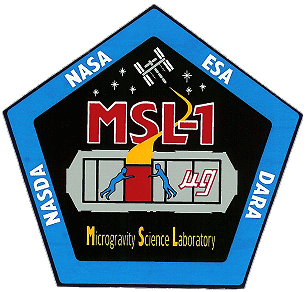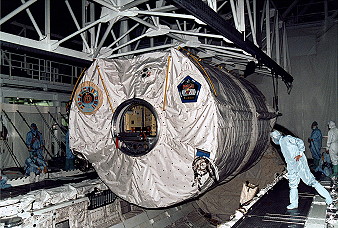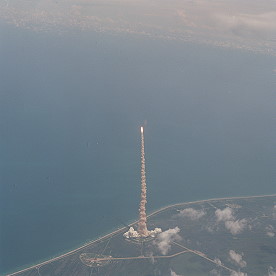Human Orbital Spaceflights
![]()
International Flight No. 196STS-94Columbia (23)85th Space Shuttle missionUSA |
 |
 |
![]()
Launch, orbit and landing data
walkout photo |
 |
||||||||||||||||||||||||||||
alternative crew photo |
Crew
| No. | Surname | Given names | Position | Flight No. | Duration | Orbits | |
| 1 | Halsell | James Donald, Jr. | CDR | 4 | 15d 16h 44m 33s | 251 | |
| 2 | Still | Susan Leigh | PLT, IV-1 | 2 | 15d 16h 44m 33s | 251 | |
| 3 | Voss | Janice Elaine | MS-1, PLC | 4 | 15d 16h 44m 33s | 251 | |
| 4 | Gernhardt | Michael Landon | MS-2, EV-1 | 3 | 15d 16h 44m 33s | 251 | |
| 5 | Thomas | Donald Alan | MS-3, EV-2, FE | 4 | 15d 16h 44m 33s | 251 | |
| 6 | Crouch | Roger Keith | PS-1 | 2 | 15d 16h 44m 33s | 251 | |
| 7 | Linteris | Gregory Thomas | PS-2 | 2 | 15d 16h 44m 33s | 251 |
Crew seating arrangement
|
 |
|
||||||||||||||||||||||||||||||||
Backup Crew
|
 |
|||||||||||||||
Hardware
| Orbiter : | OV-102 (23.) |
| SSME (1 / 2 / 3): | 2037-1A (4.) / 2034 (9.) / 2033 (9.) |
| SRB: | BI-088 / RSRM 62 |
| ET: | ET-86 (LWT-79) |
| OMS Pod: | Left Pod 05 (12.) / Right Pod 05 (11.) |
| FWD RCS Pod: | FRC 2 (23.) |
| RMS: | - |
| EMU: | EMU No. 3011 (PLSS No. 1011) / EMU No. 3015 (PLSS No. 1015) |
Flight
|
Launch from Cape Canaveral (KSC) and
landing on Cape Canaveral (KSC), Runway 15. The reflight of the MSL payload, was designated Mission STS-94, and involved the same vehicle, crew and experiment activities as originally planned earlier this year on mission STS-83. Columbia's crew continued NASA's efforts to understand the subtle and complex phenomena associated with the influence of gravity in many aspects of daily life. The flight involved the STS-94 crew spending more than two weeks in orbit as they conduct a variety of experiments to examine how various materials and liquids change and behave in the weightless environment of space. The primary focus for mission STS-94 was the same as it was for STS-83 - to conduct experiments and evaluate facilities associated with the Microgravity Science Laboratory-1 (MSL-1) payload. The MSL flight served as a bridge to America's future in space with a mission that spans the gap between the relatively short duration work done on today's Shuttle Spacelab flights to the long duration research that will be performed on the International Space Station. MSL was a collection of microgravity experiments housed inside a European Spacelab Long Module (LM). It built on the cooperative and scientific foundation of the International Microgravity Laboratory missions (IML-1 on STS-42 and IML-2 on STS-65), the United States Microgravity Laboratory missions (USML-1 on STS-50 and USML-2 on STS-73), the Japanese Spacelab mission (Spacelab-J on STS-47), the Spacelab Life and Microgravity Science Mission (LMS on STS-78) and the German Spacelab missions (D-1 on STS-61A and D-2 on STS-55). MSL featured 19 materials science investigations in 4 major facilities. These facilities were the Large Isothermal Furnace, the EXpedite the PRocessing of Experiments to the Space Station (EXPRESS) Rack, the Electromagnetic Containerless Processing Facility (TEMPUS) and the Coarsening in Solid-Liquid Mixtures (CSLM) facility, the Droplet Combustion Experiment (DCE) and the Combustion Module-1 Facility. Finally, the crew performed experiments with flame balls. There were also experiments on measuring microgravity. They included the Space Acceleration Measurement System (SAMS), the Microgravity Measurement Assembly (MMA), the Quasi-Steady Acceleration Measurement System and the Orbital Acceleration Research Experiment (OARE). Experiment operations conducted around the clock on this flight, with the astronauts divided into two teams. James Halsell, Susan Still, Donald Thomas and Gregory Linteris were the "Red Team". The "Blue Team" consisted of Janice Voss, Michael Gernhardt and Roger Crouch. The Large Isothermal Furnace was developed by the Japanese Space Agency (NASDA) for the STS-47 Spacelab-J mission and was also flown on STS-65 IML-2 mission. It housed the Measurement of Diffusion Coefficient by Shear Cell Method Experiment, the Diffusion of Liquid Metals and Alloys Experiment, the Diffusion in Liquid Led-Tin-Telluride Experiment, the Impurity Diffusion in Ionic Melts Experiment, the Liquid Phase Sintering II Experiment (LIF), and the Diffusion Processes in Molten Semiconductors Experiment (DPIMS). The Combustion Module-1 (CM-1) facility from the NASA Lewis Research Center housed experiments on Laminar Soot Processes Experiment and the Structure of Flame Balls at Low Lewis-number Experiment (SOFBALL). The Droplet Combustion Experiment (DCE) is designed to investigate the fundamental combustion aspects of single, isolated droplets under different pressures and ambient oxygen concentrations for a range of droplet sizes varying between 2 millimeters (0.079 in) and 5 millimeters (0.20 in). The DCE apparatus is integrated into a single width MSL Spacelab rack in the cargo bay. The EXPRESS rack replaces a Spacelab Double rack and special hardware will provide the same structural and resource connections the rack will have on the Space Station. It will house the Physics of Hard Spheres (PHaSE) experiment and the Astro/PGBA Experiment. The Electromagnetic Containerless Processing Facility (TEMPUS) is used for the Experiments on Nucleation in Different Flow Regimes, Thermophysical Properties of Advanced Materials in the Undercooled Liquid State Experiment, Measurements of the Surface Tension of Liquid and Undercooled Metallic Alloys by Oscillating Drop Technique Experiment, Alloy Undercooling Experiments, the Study of the Morphological Stability of Growing Dendrites by Comparative Dendrite Velocity Measurements on Pure Ni and Dilute Ni-C Alloy in the Earth and Space Laboratory Experiment, the Undercooled Melts of Alloys with Polytetrahedral Short-Range Order Experiment, the Thermal Expansion of Glass Forming Metallic Alloys in the Undercooled State Experiment, the AC Calorimetry and Thermophysical Properties of Bulk Glass-Forming Metallic Liquids experiment and the Measurement of Surface Tension and Viscosity of Undercooled Liquid Metals experiment. The Orbital Acceleration Research Experiment (OARE) makes extremely accurate measurements of these variations and other disturbances, using a sensor called an accelerometer, and records them for later analysis. Analysis of these and other types of microgravity disturbances enables researchers to assess the influence of Shuttle accelerations on the scientific experiments carried onboard the Microgravity Science Laboratory. The Orbital Acceleration Research Experiment was a self-calibrating instrument that monitored and recorded extremely small accelerations - changes in velocity - and vibrations that are experienced during orbit of the Shuttle. At the heart of the instrument is a miniature electrostatic accelerometer that precisely measured low- frequency, on-orbit acceleration disturbances. The OARE was capable of sensing and recording accelerations on the order of one- billionth the acceleration of Earth's gravity - 1 nano-g - at a frequency of less than 1 Hertz, or once per second. The Middeck Glovebox offered scientists the capability to conduct experiments, test science procedures, and develop new technologies in microgravity. The facility enabled crew members to handle, transfer, and manipulate experiment hardware and materials that are not approved for use in the open Spacelab. In addition, the facility was equipped with photographic equipment and video and data recording capability, allowing a complete record of experiment operations. The Cryogenic Flexible Diode (CRYOFD) heat pipe experiment was a Hitchhiker payload flying on Space Shuttle Columbia during the STS-94 mission. Flight testing of heat pipes in space is being conducted to gain advances in passive thermal control technology. Engineers hope to transfer any technology achieved in space to commercial applications on Earth. There were two CFDHP units: one used oxygen as the working fluid to operate at temperatures as low as 60 Kelvin; the other used methane to operate at temperatures as low as 100 Kelvin. These heat pipes incorporated unique flexible wick designs and flexible bellows to permit easier integration into a spacecraft or with an instrument. Since they are flexible, heat pipes also permit pointing of the instrument. The Large Isothermal Furnace was a facility capable of uniformly heating large samples of metal alloys to 2,912 degrees Fahrenheit (1,600 degrees Celsius) and rapidly cooling samples using a flow of helium. A vacuum-heating facility, the furnace consists of a sample container and heating element surrounded by a vacuum chamber. The furnace was used to study the diffusion of liquid metals - the process by which liquid metals mix when heated. This process cannot adequately be studied on Earth because of convection. The first, convection, was the transfer of heat caused by the movement of fluid particles which results from a variation in concentration and gravity. On Earth, liquids will gradually mix as a result of heat and stirring generated by convection. To study the effect of an outside source of heat and stirring on the mixing process, it is necessary to reduce or eliminate convection. In the near-zero gravity aboard the orbiting Space Shuttle, researchers are able to study the diffusion process unaffected by convection. The experiments may provide a better understanding of how liquid metals mix, a process vital to the production of high-quality metal alloys and products. Space Acceleration Measurement System (SAMS): The effects of Earth's gravity on the Space Shuttle and its cargo are markedly reduced when in orbit. But so strong are the forces of gravity, the effects are never completely eliminated. Disturbances occur when crew members move about the Shuttle, when onboard equipment is operated, or thrusters are fired to maneuver the Shuttle to its proper position. Even slight, atmospheric drag on the Shuttle can create disturbances that mimic gravity. Such minute changes in the orbital environment of the Shuttle can effect sensitive experiments being conducted onboard. Researchers and scientists conducting experiments on the Microgravity Science Laboratory mission will depend on the Space Acceleration Measurement System to record precise measurements of such changes. The system will enable them to adjust their experiments and improve the collection of scientific information during the mission. The system's measurements also aid in determining how vibrations or accelerations affect the results of experiments. The system accurately measured and mapped the acceleration environment in orbit, using three remote sensor heads mounted in different locations. Each sensor head had three accelerometers oriented to enable the detection of accelerations three-dimensionally, in the range of .01- to 100-Hertz. For this mission, one sensor head detected accelerations up to 2.5 Hertz, while others can detect accelerations up to 25 Hertz. Information collected by the sensors was transmitted to the ground through the Shuttle's communications system. This allowed scientists to make immediate assessments of the effects of the microgravity environment, and make necessary corrections for their experiments. One of the systems developed to measure disruptions to experiments caused by accelerations was the Microgravity Measurement Assembly (MMA). Many experiments onboard the Microgravity Science Laboratory require a very smooth ride through space so that their delicate operations are not disturbed. Yet even in the quiet, low-gravity environment of space, disruptions occur from movements by the crew, equipment operations and occasional firing of thrusters to adjust the orbital position of the Shuttle. The Microgravity Measurement Assembly determined both high- and low-frequency spacecraft disturbances, collecting measurements from seven sensor heads placed at selected locations in the Spacelab. Four of the sensor heads were placed in the Spacelab experiment racks, where many of the gravity-sensitive investigations were located. Most of the MMA sensors could detect accelerations in the range of 0.1- to 100-Hertz. One sensor, called the Accelerometre Spatial Triaxial Electrostatique, could measure accelerations below 1.0 Hertz. STS-94 included Amateur (or "ham") radio, where radio operators and students could attempt to make radio contacts with the orbiting Shuttle as part of a project called Shuttle Amateur Radio EXperiment, or SAREX. Amateur Radio has been flying aboard the Shuttles since 1983. Ham radio operators from around the world pointed their antennas at the Space Shuttle Columbia, hoping to find the astronauts on-the-air. Some of these amateurs have volunteered to assist student groups who have prepared questions to ask the astronauts during specially scheduled contact times. To make their radio contacts, the astronauts used a radio aboard the Shuttle on frequencies used by ham radio operators. To operate Amateur Radio from the Space Shuttle, one or more of the astronauts must have an Amateur Radio license. The STS-94 crew members who are licensed Amateur Radio operators included Commander James Halsell, Payload Commander Janice Voss, and Mission Specialist Donald Thomas. |
Photos / Graphics
 |
 |
 |
 |
 |
 |
 |
 |
 |
 |
 |
 |
 |
 |
 |
 |
| © |  |
Last update on June 20, 2023.  |
 |